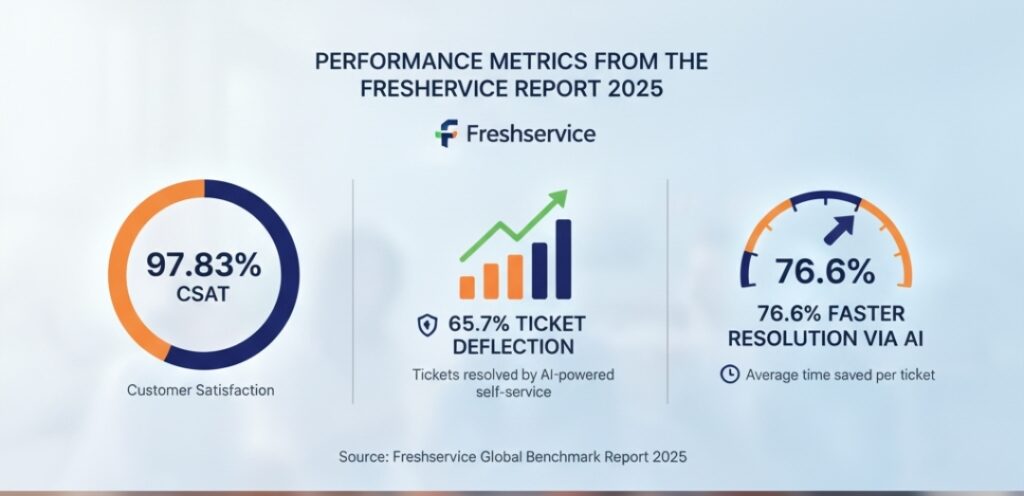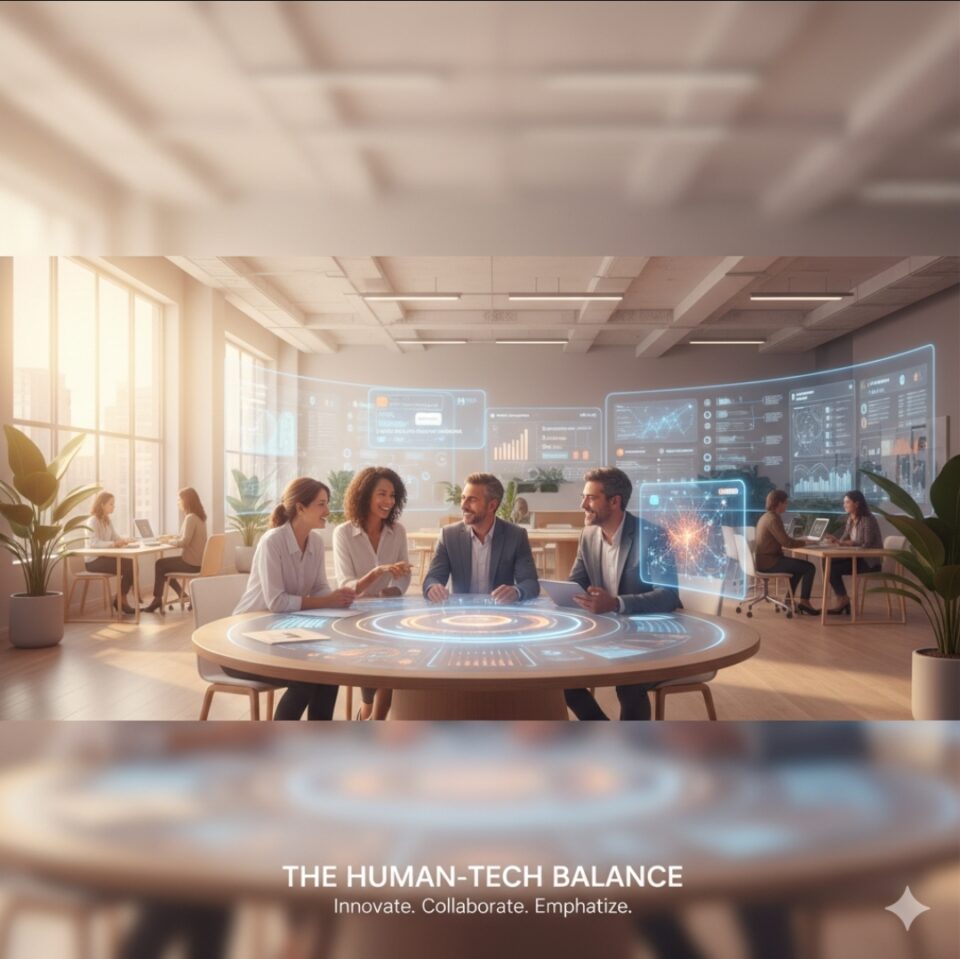The Experience Convergence: How AI, Simplicity, and Empathy Are Redefining the Future of Work According to Freshservice Benchmark Report
Ever noticed how the smallest tech hiccup can throw off an entire workday?
A password reset link that won’t open.
A virtual meeting platform that freezes just before a pitch.
A support ticket marked “urgent” but answered hours later.
In that fleeting moment, what begins as an IT issue quietly becomes a trust issue. It shapes how employees feel about their organization — and how that emotion, in turn, ripples outward to the customer.
Welcome to the new frontier of experience. Here, employee experience (EX) and customer experience (CX) no longer run on parallel tracks. They are interlocked, feeding and reflecting each other in real time.
The Freshservice Benchmark Report 2025 offers an illuminating snapshot of this shift. With over 431,000 hours saved through AI-led automation and record-high satisfaction levels, it’s not just a tech story — it’s a story about how work itself is evolving.
Let’s unpack the lessons every CX and EX leader can use right now.
Freshservice Benchmark Report : When Service Becomes the Soul of Experience
For years, service desks were viewed as functional support units — essential, but not strategic. That narrative has changed. In 2025, IT service management (ITSM) is emerging as the beating heart of employee experience.
The numbers say it all.
- Customer satisfaction (CSAT) for IT and business teams reached 97.83%, the highest in five years.
- First Contact Resolution (FCR) soared to 74.14%, reflecting quicker, smarter interventions.
- Average Resolution Time (ART) fell to 21.96 hours, marking a 10% improvement year over year.
This isn’t just about efficiency. It’s about emotional resonance — the sense of reliability employees feel when technology works seamlessly.
Because when internal service breaks, so does focus. And when focus breaks, customer empathy falters.
The AI Evolution: From Pilot Projects to Proven Payoffs
The age of cautious AI experimentation is over. 2025 is the year AI has matured into measurable business impact.
Freshservice’s Freddy AI ecosystem is a standout example. Its AI Agent deflected 65.7% of tickets, translating to 431,270 hours of manual effort saved. Meanwhile, the AI Copilot cut resolution time by 76.6% and improved first response time by 41.1%.
These aren’t futuristic forecasts — they’re operational realities.
As Shalindra Singh, a global service delivery leader quoted in the report, puts it:
“Because of the Freddy AI virtual bot, we could deflect 65% of tickets and focus on meaningful work.”
The secret? It’s not AI alone — it’s AI with intentional design. Organizations that simplified processes before layering automation saw the strongest outcomes.
In contrast, companies that bolted AI onto complex, fragmented systems often saw diminishing returns. AI can’t fix what’s fundamentally broken — but it can supercharge what’s already streamlined.
Simplify Before You Scale
Complexity is the silent killer of experience. Each tool, workflow, and disconnected platform adds friction that AI cannot hide.
The benchmark data proves that simplification is the foundation of scalability:
- Teams that consolidated and automated workflows achieved a 5.43% faster resolution time.
- They also saw a 6.19% improvement in first contact resolution.
- Even small teams — once seen as resource-constrained — reported disproportionate gains when they automated repetitive tasks.
This pattern holds a universal truth for CX leaders:
Before you chase innovation, fix the clutter.
Remove redundant touchpoints, standardize handoffs, and unify your tech stack. Automation works best when it’s built on clean, comprehensible foundations.
The Power of Tiny Levers: Priority, Integration, and Canned Responses
Sometimes, big transformations start with small operational levers.
Freshservice’s data highlights three underrated heroes:
- Priority matrices cut resolution time by 29.26%.
- System integrations reduced average resolution time by 6.9%.
- Canned responses shaved off 8.16% of handling time.
These are deceptively simple improvements — but they work because they bring clarity. When agents know what to prioritize, where data lives, and how to respond efficiently, the entire service rhythm becomes smoother.
For CX professionals, the parallel is clear: whether it’s customer queries or employee tickets, clarity beats complexity every time.
Knowledge as Currency
A well-written article in a knowledge base can be more powerful than any AI model.
Nearly 71% of organizations in the report used internal knowledge bases, leading to a 5% drop in resolution time. That’s because empowered employees — and customers — prefer self-service that works.
But the insight goes deeper: knowledge needs to evolve with the organization. Static content is worse than none at all. Regularly updated knowledge, paired with contextual AI retrieval, keeps experiences fluid and consistent.
When knowledge becomes part of the workflow instead of a separate repository, learning transforms into living CX.

IT Asset Management (ITAM): The Unsung Hero of Efficiency
Behind every fast ticket resolution lies accurate asset visibility.
70% of organizations now use IT Asset Management systems, not just for compliance but for strategic insight. Teams recovered $53.6 million worth of unused software licenses and cut ART by 8.28%.
ITAM is no longer a back-office task — it’s a performance enabler. Knowing which devices, licenses, or configurations are linked to each employee means faster resolutions and proactive prevention.
For CX and EX leaders, it’s a reminder that data context fuels experience clarity.
ESM: Taking Service Beyond IT
Enterprise Service Management (ESM) is extending IT’s rigor to every department — HR, Finance, Facilities, and more.
Business teams using ESM achieved an average resolution time of 29.08 hours and a First Contact Resolution of 79.5%. The ratio of business agents to IT agents is now 10:14, showing that the service mindset is spreading across the enterprise.
This convergence signals a cultural shift:
CX is no longer confined to customer touchpoints. It’s embedded in how employees request, receive, and deliver support internally.
A frictionless EX sets the stage for effortless CX.
Channel Strategy: Designing for Context
Every channel has a purpose. The key is to match the medium to the moment.
The report shows:
- Phone tops First Contact Resolution at 91.23%.
- Chat and collaboration tools offer the fastest assignment speeds.
- Email still leads in low Average First Response Time for complex queries.
The takeaway? Don’t chase omnichannel for its own sake. Instead, design a contextual channel mix — voice for empathy, chat for speed, and email for thoughtful follow-up.
People-First AI: The Future of Empowerment
One of the most encouraging trends in the benchmark is the rise of AI that amplifies, not replaces.
AI copilots are helping agents handle tickets faster, summarize complex issues, and even craft empathetic responses. One customer reported saving 200 hours per month after deploying a copilot for internal support.
The emotional impact matters. Agents feel less overwhelmed. Employees get faster, more human responses. The experience loop tightens.
For CX and EX leaders, the mandate is clear: augment human judgment, don’t automate it away.
From SLAs to XLAs: Measuring What Really Matters
Traditional Service Level Agreements (SLAs) focus on time. But Experience Level Agreements (XLAs) focus on feeling.
The benchmark points to a growing trend — measuring how effectively an incident restores productivity, not just how quickly it closes.
- Did the employee get back to work seamlessly?
- Did the interaction rebuild confidence?
- Did it eliminate future friction?
CX and EX professionals who adopt XLAs find richer insights — ones that bridge emotion and efficiency.
Expert Lens: What Leaders Are Saying
“AI cut handling time by nearly half — but only after we simplified our processes,” shared a technology head quoted in the study.
“Freddy AI reduced our ticket workload dramatically, freeing agents to focus on innovation,” noted another.
The message from practitioners is consistent:
AI delivers results only when layered over clarity, discipline, and empathy.
The Action Plan: 10 Moves for CX and EX Leaders
- Audit complexity. Map your current tools, overlaps, and redundant workflows.
- Simplify first. Consolidate before you automate.
- Automate wisely. Focus on repetitive, rule-based tasks with measurable outcomes.
- Invest in AI copilots. Use them for summarization and guidance, not decision-making.
- Empower self-service. Build living knowledge bases and measure content usefulness.
- Integrate ITAM insights. Link asset visibility to service requests.
- Redesign your channels. Match channel to context, not convenience.
- Expand ESM. Apply ITSM principles to every internal service team.
- Adopt XLAs. Pair speed metrics with sentiment and productivity.
- Train for empathy. Teach agents to humanize every interaction, even automated ones.
Final Thoughts: The Human Algorithm in Freshservice Benchmark Report
As organizations race toward AI-driven service, one truth stands firm — technology shapes experience only when guided by empathy.
The Freshservice Benchmark Report 2025 shows that the best-performing teams don’t just deploy automation. They engineer confidence, clarity, and care into every interaction.
In the end, the convergence of CX and EX is not a digital story — it’s a human one.
The companies that will thrive in 2025 and beyond are those that understand this equation:
Better tools + Empowered people + Simplified processes = Unbreakable trust.
And trust, as every great experience leader knows, is the one metric that never lies.

